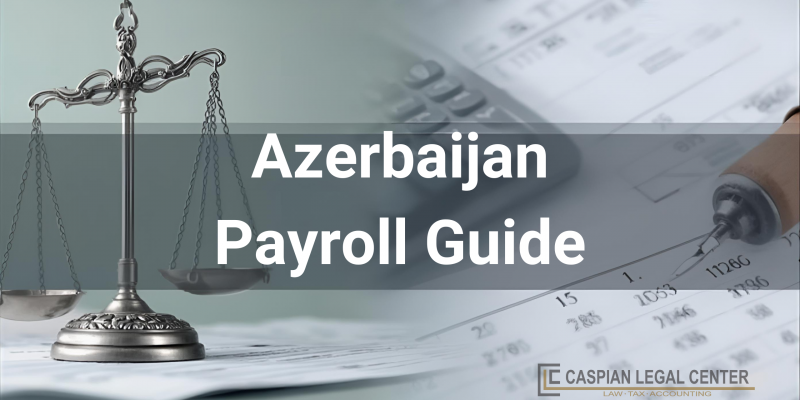Payroll, in simple terms, covers the calculation and distribution of payments to employees. This process, envisaging salary and other mandatory payments to the employees in line with the Labor Code, is further sophisticated due to deductions pertaining to income tax, state social protection fund (“SSPF”) allocations and other mandatory social contributions. The following information, along with examples, shed light into the rules and procedures carried out in Azerbaijan in various contexts.
Payroll calculations are one of the most sophisticated human resources issues related to payroll in Azerbaijan.
Deductions formula can be presented as follows:
Accrued salary - Income tax - SSPF deductions - Unemployment insurance premium - Compulsory health insurance premium = Net salary
The primary aspect of the salary calculation is the accurate representation of deductions, which results in the determination of net salary out of gross salary. The following circumstances must be determined in the initial stages of the calculation process:
1. Whether the employee works in non-state and non-oil & gas sector or is employed by State companies and oil & gas sector;
2. Whether the employee falls under the preferential or non-preferential provisions in regards to income tax and social contributions including SPF, UIC and MHI in other words whether the employee is subject to income tax concessions.
In the light of the provided answers the calculation will be conducted as below.
There is no separate concept of payroll taxes in Azerbaijan. Payroll payments are taxed in line with personal income tax and mandatory social contributions. Below we explain taxation aspects of payroll in Azerbaijan.
Deductions from employees
Regarding the income tax, the exact amount of salary of the employee is crucial. If the taxable amount is up to 2500 manat, 200 manat is subtracted from the taxable amount, namely the whole salary, then the remaining part must be multiplied by 14%. If the taxable amount is more than 2500 manat, then 2500 manat is subtracted from the salary, then the remaining is multiplied by 25%, lastly adding 350 manat.
Regarding the SSPF allocations, monthly salary is multiplied by 3%.
Regarding the unemployment insurance premium, accrued monthly salary is multiplied by 0.5%.
Regarding the compulsory health insurance premium, the exact amount of salary alters the dynamics. If the salary is up to 8000 manat, calculated monthly salary is multiplied by 2%.
If the salary is more than 8000 manat, 8000 manat is subtracted from monthly salary, then the remaining amount is multiplied by 0.5%, lastly adding 160 manat.
The employee working in SOCAR receives 8500 manat monthly salary in gross, his salary in net, meaning the amount will be paid to her\him is 6190 AZN:
GROSS Salary | Income tax | SSPF allocations | Unemployment insurance premium | Compulsory health insurance premium | NET Salary |
| 8500₼ | (8500-2500) * 25% + 350 = 1850 | 8500 * 3%=255 | 8500 * 0.5%=42.5 | 160 + (8500 - 8000) * 0.5% = 162.5 | 6190₼ |
Deductions from employers
Regarding the SSPF allocations, monthly salary of the employee (“monthly salary” hereinafter) is multiplied by 22%.
Regarding the unemployment insurance premium, accrued monthly salary is multiplied by 0.5%.
Regarding the compulsory health insurance premium, the exact amount of salary alters the dynamics. If the salary is up to 8000 manat, calculated monthly salary is multiplied by 2%.
If the salary is more than 8000 manat, 8000 manat is subtracted from monthly salary, then the remaining amount is multiplied by 0.5%, lastly adding 160 manat.
For the employee in Example 1, the employer will pay 2075 AZN:
GROSS Salary | SSPF allocations | Unemployment insurance premium | Compulsory health insurance premium | Amount to be paid |
| 8500₼ | 8500 * 22%=1870 | 8500 * 0.5%=42.5 | 160 + (8500 - 8000) * 0.5% = 162.5 | 2075₼ |
Deductions from employees
Regarding income tax, the exact amount of salary of the employee must be established. If the taxable amount is up to 8000 manat, 0% tax is deducted. If the taxable amount is more than 8000 manat, then the salary is multiplied by 14%.
Regarding SSPF allocations, if the salary is up to 200 manat, monthly salary is multiplied by 3%. If the salary is more than 200 manat, 200 manat is subtracted from salary, the remaining amount is multiplied by 10%, lastly adding 6 manat.
Regarding unemployment insurance premium, accrued monthly salary is multiplied by 0.5%.
Regarding compulsory health insurance premium, the exact amount of salary alters the dynamics. If the salary is up to 8000 manat, calculated monthly salary is multiplied by 2%.
If the salary is more than 8000 manat, 8000 manat is subtracted from monthly salary, then the remaining amount is multiplied by 0.5%, lastly adding 160 manat.
The employee working in Caspian Legal Center receives 3000 manat monthly salary in gross, his salary in net, meaning the amount will be paid to her\him is 2639 AZN:
GROSS Salary | Income tax | SSPF allocations | Unemployment insurance premium | Compulsory health insurance premium | NET Salary |
| 3000₼ | 3000 * 0% = 0 | 6 + (3000-200) * 10% = 286 | 3000 * 0.5%=15 | 3000 * 2% = 60 | 2639₼ |
Deductions from employers
Regarding SSPF allocations, if the salary is up to 200 manat, monthly salary is multiplied by 22%. If the salary is more than 200 manat, 200 manat is subtracted from salary, the remaining amount is multiplied by 15%, lastly adding 44 manat.
Regarding unemployment insurance premium, accrued monthly salary is multiplied by 0.5%.
Regarding compulsory health insurance premium, the exact amount of salary alters the dynamics. If the salary is up to 8000 manat, calculated monthly salary is multiplied by 2%.
If the salary is more than 8000 manat, 8000 manat is subtracted from monthly salary, then the remaining amount is multiplied by 0.5%, lastly adding 160 manat.
For the employee in Example 3, the employer will pay 539 AZN:
GROSS Salary | SSPF allocations | Unemployment insurance premium | Compulsory health insurance premium | Amount to be paid |
| 3000₼ | 44 + (3000-200) * 15% = 464 | 3000 * 0.5%=15 | 3000 * 2% = 60 | 539₼ |
According to Tax Code of Azerbaijan, certain categories of employees receive concessions, namely the taxable amount of their salary is subjected to reductions. These concessions are granted whether the employee works in non-state and non-oil sector or he\she is employed by State companies:
1. Taxable income is reduced by 800 AZN
2. Taxable income is reduced by 400 AZN
3. Taxable income is reduced by 200 AZN
4. Taxable income is reduced by 100 AZN
5. Taxable income is reduced by 50 AZN
One of the spouses who has at least three dependents, regardless of the degree of kinship, including pupils and students under the age of 23 who are studying in the morning
If the employee in the Example 1 is a parent of a fallen fighter, income tax is deducted from 8400 manat, considering 100 AZN concession. Hence, the net salary amounts to 6215 AZN:
GROSS Salary | Income tax | SSPF allocations | Unemployment insurance premium | Compulsory health insurance premium | NET Salary |
| 8500₼ | (8400 - 2500) * 25% + 350 = 1825 | 8500 * 3%=255 | 8500 * 0.5%=42.5 | 160 + (8500 - 8000) * 0.5% = 162.5 | 6215₼ |
Payment for the annual leave is strictly regulated by the Labour Code. In fact, errors while making calculation for such mandatory leave payment (“vacation pay”) are among the mostly sought areas of assistance regarding Azerbaijan’s payroll regulations.
The average salary paid for the vacation period is determined based on the average salary for the 12 calendar months preceding the month in which the vacation is granted. The average monthly salary of an employee who has worked for less than 12 calendar months and has taken vacation is calculated based on the full calendar months actually worked.
The average monthly salary is found by dividing the total salary for the 12 calendar months preceding the vacation by 12, and the amount of one day's salary is determined by dividing the resulting amount by the average annual number of calendar days in the month - 30.4. The amount of one day's salary determined in this way is multiplied by the number of calendar days of the vacation period.
Holidays that are not considered working days and fall within the vacation period are not included in the calendar days of the vacation and are not paid.
The employee wants to take an 8-day leave from January 1st to 8th for January 2025, considering there are 18 working day. As January 1st and 2nd are holidays which are not considered working days, they are not included in the period. Therefore, for the vacation calculation purposes, employee`s vacation days will be considered 6 calendar days, and for the monthly salary calculation purposes, 4 working days will be deducted from the total work days (03, 06, 07, 08 January).
The employee's average monthly salary is 1000 manat, determined by dividing the employee's salary for the 12 calendar months preceding the vacation amounting to 12000 manat by 12 months.
Vacation pay: 1000/30.4 * 6 = 197.36 manat
Monthly pay: 1000/18 * 14 (work days) + 197.36 = 974.14 manat
Unless the employee requests another day off instead, in the time-based system of payment for labor, not less than twice the daily tariff salary is paid. In the piece-rate system of payment for labor, not less than twice the daily salary is paid. For employees receiving a monthly salary, if the work was performed within the monthly working time norm, salary cannot be less than the daily position salary in addition to the salary. For this last point:
An employee's monthly salary is 800 manat and there are 22 working days in December 2025. If the employee works 21 working days full time and works on World Azerbaijanis Solidarity Day (31st December – non-working day) not exceeding monthly working time (20*8 + 7 + 1*8 = 175h), for that day his/her monthly salary must be paid a minimum of:
800 manat (monthly salary) + (800÷22) (daily position salary for work on holiday) = 836.36 manat
The same case as aforementioned by, but this time the employee works only 4 hours on World Azerbaijanis Solidarity Day (31st December – non-working day) not exceeding monthly working time (20*8 + 7+ 1*4 = 171h), for that day his/her monthly salary must be paid a minimum of:
800 manat (monthly salary) ÷ 175h (monthly working hours) = 4.57 manat (hourly tariff salary)
4.57 * 4h = 18.28 manat
Monthly salary eventually amounts to 800 + 18.28 = 818.28 manat
For employees receiving a monthly salary, if the work was done in excess of the monthly working hours, in addition to the salary, not less than double the daily salary must be paid.
If the monthly working hours norm is 160 hours, and the employee works 4 hours on a holiday that is not considered a working day in this month. Therefore, the actual working hours in that month are 164 hours, and hourly tariff salary amounts to 5 manat. The monthly salary:
5 * 4h * 2 = 40 manat (for work in excess of working hours norm)
Monthly salary eventually amounts to 160 * 5 + 40 = 840 manat
An additional payment is determined for each hour of work performed at night in the amount of 20 percent of the hourly tariff salary, for each hour of work in the evening shift of the multi-shift work regime in the amount of 20 percent of the hourly tariff salary of the employee, and for night shifts in the amount of 40 percent.
A work shift in which at least half of the working time falls at night (from 10 p.m. to 6 a.m.) is considered a night shift. The work shift preceding a night shift is considered an evening shift, regardless of the start and end times of the work shift.
The enterprise employs three-shift work regime: 8 p.m. – 4 a.m., 4 a.m. – 12 p.m., 12 p.m. – 8 p.m. The employee performs his labour functions on the first shift, 8 p.m. – 4 a.m. His monthly salary amounts to 3200 manat and monthly working hours for July equals 160h. The payment for one day work will be calculated as follows:
More than the half of the working time falls at night: 6 hours (10 p.m. – 4 a.m.), hence, this works is considered a night shift.
3200/160 = 20 manat (hourly tariff salary)
20 * 40/ 100 = 8
8 * 8 (hours on the night shift) = 64 manat (additional payment)
Full payment for that day = 160 + 64 = 224 manat
If that employee was working from 12 p.m. – 8 p.m., namely on the working shift preceding the night shift, then:
20 * 20/ 100 = 4
4 * 8 (hours on the evening shift) = 32 manat (additional payment)
Full payment for that day: 160 + 32 = 192 manat
Other work regimes organized in accordance with the requirements of the legislation (partition of the working day into parts, etc.) are not considered multi-shift work regimes. Employees working in such work regimes are paid an additional amount of 20 percent of the hourly tariff salary for each hour of working time falling on the night time.
Example 12:
The same employee performs her work on the basis of split work regime, namely she works from 5 p.m. – 7 p.m., 11 a.m. – 1 p.m., 9 p.m. – 1 a.m. on Tuesday. For that day payment shall be accounted as:
20 manat (hourly tariff salary) * 20/ 100 (for additional payment) = 4 manat
4 manat * 3 (hours falling on the night time: 10 p.m. – 1 a.m.) = 12 manat
Full payment for that day: 160 manat + 12 manat = 172 manat
Labor Code specifies very diverse rules for the overtime payments in Azerbaijan. Persons involved in Azerbaijani payroll issues and particularly foreign HR managers/experts need professional support from domestic payroll service experts. It is one of the mostly debated topics of payroll in Azerbaijan, due to vague legal provisions.
In the time-based system of payment of labor, employees are paid an additional payment not less than the double amount of the hourly tariff salary for each hour of work performed overtime. In the piece-rate system of payment of labor, they are paid an additional payment not less than the hourly tariff salary of a time-based employee of the appropriate rank.
While this calculation does not seem complicated, uncertain points arise in the following circumstances:
When calculating overtime pay, it's paramount to recognize that overtime pay is not a supplement, but double tariff salary. Therefore, all supplements such as night work pays must be calculated based on the overtime pays. So, if overtime work is performed during night hours, since overtime pay equals double the tariff salary, the night work supplement should be applied to this doubled tariff amount.
The employee’ working hours start 2 p.m. continues till 10 p.m. On Tuesday she works till 12 p.m., bearing in mind that the period from 10 p.m. to 6 a.m. is night. Her hourly tariff salary equals to 10 manat. Her payment for full day work will be:
Overtime pay: 10 * 2h * 2 = 40 manat
For night work: 40 * 20/ 100 = 8 manat
Full payment for that day: 10 * 8 + 40 + 8 = 128 manat
Again, as overtime pay is not a supplement, but double tariff salary, all payment for work in difficult conditions must be calculated based on the overtime pays. And this double tariff salary will be applied in accordance with the coefficient in indicated in the Decision No. 137 dated 22.08.2002, of the Cabinet of Ministers of the Republic of Azerbaijan "On the determination of the minimum amount of increases (coefficients) ensuring high salary for employees working in jobs with difficult and harmful working conditions and in workplaces that are not suitable for work due to climatic conditions, and for specialists working in the liberated territories of the Republic of Azerbaijan” (hereinafter “the Decision”).
The employee with an hourly tariff salary of 20 manats working 70 km from the shore of the Caspian Sea completes her labour duties in 9 hours, one hour more than her daily working time norm. The pay calculation will be conducted as below:
The minimum amount of increase (coefficient) to the tariff (position) salaries of workers employed at facilities located in the Caspian Sea has been determined depending on the connection conditions with the shore. According to the Decision, the minimum amount for employees operating 70 km from shore has been set at 1.75. Hence,
Overtime pay: 20 * 2 = 40 manat
Overtime pay for work in difficult conditions: 40 * 1.75 = 70 manat
Full payment for that day: 20 * 8 * 1.75 + 70 = 350 manat
The same employee performs that work at night:
Overtime pay: 20 * 2 = 40 manat
Overtime pay for work in difficult conditions: 40 * 1.75 = 70 manat
For night work: 70 * 20/ 100 = 14 manat
Full payment for that day: 20 * 8 * 1.75 + 70 + 14 = 364 manat
When applying cumulative working time accounting, the working time norm for the accounting period is adjusted by considering work hours that coincide with periods when the employee is on leave, temporarily incapacitated, or receiving average salary compensation. In other words, the working time norm for the accounting period is reduced by the number of work hours that fall within these periods according to the shift schedule. At the end of the accounting period, to determine overtime hours, adjusted work hours will be subtracted from the actual work hours for the period.
The enterprise has established cumulative working time accounting on an annual basis, with the accounting period covering from January 1, 2024, to December 31, 2024. According to the calendar, the total standard working time for this period amounts to 1,901 hours. The employee actually worked 1,920 hours during this period. Additionally, the same employee was on annual leave for 10 calendar days (totaling 80 hours) within the accounting period. In this case, the overtime hours calculation is as follows:
The standard working time norm of 1,901 hours is adjusted by subtracting the 80 hours that coincided with the annual leave period, resulting in a norm of 1,821 hours.
Then, overtime amounts to: 1,920h - 1,821h = 99 overtime hours
The illustrations and examples given above about payroll in Azerbaijan shall not be considered as advisory or recommendations. The contents of this payroll guide provide clarification for the general principles of payroll regulations in Azerbaijan, and case-specific exceptions and specific situations may arise. For a professional payroll calculation, expert involved is needed in each case.
Contact us for the clarification of Azerbaijan’s payroll regulations or payroll services requests: [email protected]; +994 50 289 89 73
Effective from 2020 the Tax Code of Azerbaijan would be amended. In this article, we summarize th...
Payroll services, HR documentation, paying payroll taxes, payroll consultancy are among our servi...
Azerbaijani lawyers and Legal Services in Azerbaijan. Contact us for lawyer and attorney support ...
Foreigners can buy property in Azerbaijan. Here we explain legal status and procedures for buying...





